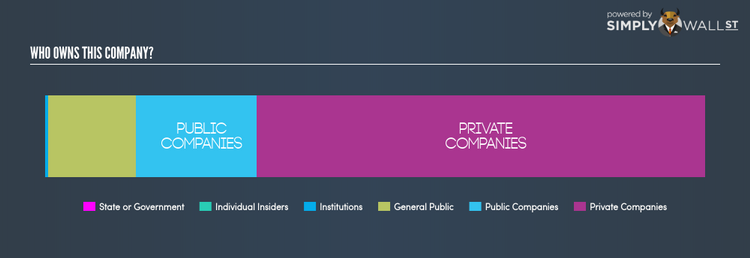Should You Be Concerned About Tata Teleservices (Maharashtra) Limited’s (NSE:TTML) Shareholders?

I am going to take a deep dive into Tata Teleservices (Maharashtra) Limited’s (NSEI:TTML) most recent ownership structure, not a frequent subject of discussion among individual investors. A company’s ownership structure is often linked to its share performance in both the long- and short-term. Differences in ownership structure of companies can have a profound effect on how management’s incentives are aligned with shareholder returns, which is why we’ll take a moment to analyse TTML’s shareholder registry.
See our latest analysis for Tata Teleservices (Maharashtra)
Institutional Ownership
Institutional investors transact in large blocks which can influence the momentum of stock prices, at least in the short-term, especially when there is a low level of public shares available on the market to trade. With hardly any institutional ownership, TTML stock poses limited concern relating to the effect institutional block trades have on its stock price.
Insider Ownership
I find insiders are another important group of stakeholders, who are directly involved in making key decisions related to the use of capital. In essence, insider ownership is more about the alignment of shareholders’ interests with the management. Although individuals in TTML hold only a minor stake, it’s a good sign for shareholders as the company’s executives and directors have their incentives directly linked to the company’s performance. I will also like to check what insiders have been doing recently with their holdings. Insider buying may be a sign of upbeat future expectations, however, selling doesn’t necessarily mean the opposite as insiders may be motivated by their personal financial needs.
General Public Ownership
A big stake of 13.27% in TTML is held by the general public. This size of ownership gives retail investors collective power in deciding on major policy decisions such as executive compensation, appointment of directors and acquisitions of businesses. This level of ownership gives retail investors the power to sway key policy decisions such as board composition, executive compensation, and potential acquisitions. This is a positive sign for an investor who wants to be involved in key decision-making of the company.
Private Company Ownership
Another important group of owners for potential investors in TTML are private companies that hold a stake of 67.89% in TTML. These are companies that are mainly invested due to their strategic interests or are incentivized by reaping capital gains on investments their shareholdings. This kind of ownership, if predominantly strategic, can give these companies a significant power to affect TTML’s business strategy. Thus, potential investors should look into these business relations and check how it can impact long-term shareholder returns.
Next Steps:
Institutional ownership in TTML is not at a level that would concern investors. We are less likely to see sustained downtrends or significant volatility resulting from large institutional trading. However, if you are building an investment case for TTML, ownership structure alone should not dictate your decision to buy or sell the stock. Rather, you should be looking at fundamental drivers such as Tata Teleservices (Maharashtra)’s past track record and financial health. I urge you to complete your research by taking a look at the following:
1. Financial Health: Is TTML’s operations financially sustainable? Balance sheets can be hard to analyze, which is why we’ve done it for you. Check out our financial health checks here.
2. Past Track Record: Has TTML been consistently performing well irrespective of the ups and downs in the market? Go into more detail in the past performance analysis and take a look at the free visual representations of TTML’s historicals for more clarity.
3. Other High-Performing Stocks: Are there other stocks that provide better prospects with proven track records? Explore our free list of these great stocks here.
NB: Figures in this article are calculated using data from the last twelve months, which refer to the 12-month period ending on the last date of the month the financial statement is dated. This may not be consistent with full year annual report figures.
To help readers see pass the short term volatility of the financial market, we aim to bring you a long-term focused research analysis purely driven by fundamental data. Note that our analysis does not factor in the latest price sensitive company announcements.
The author is an independent contributor and at the time of publication had no position in the stocks mentioned.

